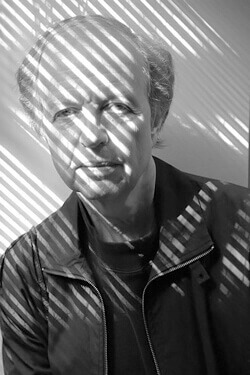Harvey Stein is a professional photographer, teacher, lecturer, author and curator based in New York City. He currently teaches at the International Center of Photography and conducts his workshops worldwide as well as in the United States. Stein is a frequent lecturer on photography both in the United States and abroad. He was the Director of Photography at Umbrella Arts Gallery, located in the East Village of Manhattan from 2009 until 2019 when it lost its lease and closed. Stein's photographs have been widely exhibited in the United States and Europe, 86 one-person and over 165 group shows to date and has published eight books. We asked him a few questions about his life and work:
All About Photo: What do you wish to convey in your photography?
Harvey Stein: I wish to convey a sense of life glimpsed, a sense of contingency and ephemerality. In experiencing these glimpses of life, I hope in turn to become more aware and knowing of my own life.
I believe photographs speak to us; they are reminders of the past. To look at a family album is to recall a vanished memory or to see old friends materialize before our eyes. In making photographs, the photographer is simultaneously a witness to the moment and a recorder of its demise; this is the camera’s power. Photography’s magic is its ability to touch, inspire, sadden, and to connect to each viewer according to that person’s unique sensibility and history. .
Tell us about your first introduction to photography? What drew you into this world?
This was a long process. While in college studying metallurgical engineering at Carnegie-Mellon University, I became excited by my electives; classes such as English literature, creative writing, theater, and anthropology. The school had a great program in art and theater, and many of my friends there were art majors. I became less and less interested in engineering, but by the time I realized this, I had a year left until graduation. Financially, I couldn't change majors at that late date so I graduated in engineering, knowing that I would not practice it very long after leaving school. I tried to paint, write, Idid ceramics while working full time as an engineer for the Bethlehem Steel Company. I was searching for a more creative life. After a year, since I took R.O.T.C. in college, I had to serve in the U.S. Army for two years as a lieutenant. While in Germany, I bought a Zeiss Icon Contaflex camera. It was not expensive at the time, and still a very good camera. Almost immediately, I fell in love with photography. It was the creative outlet I was seeking. A darkroom was available on our base, and I taught myself how to make prints. I took my camera with me everywhere and started to photograph my platoon and various Army maneuvers. I traveled all over Europe and photographed for three months after being released from the Army, doing mostly scenics and landscapes. Upon returning to the States and working for another nine months for the steel company, I moved to New York City and was accepted in the MBA program at Columbia University. In addition to my studies, I found time to photograph around New York, this was in the late 1960's. The city was alive and fertile for photographing in the streets, and somewhat dangerous in many neighborhoods. But I found it very exciting and vibrant; i loved being on the streets approaching strangers with the camera. It was the start of my life long career doing portraiture and street work.
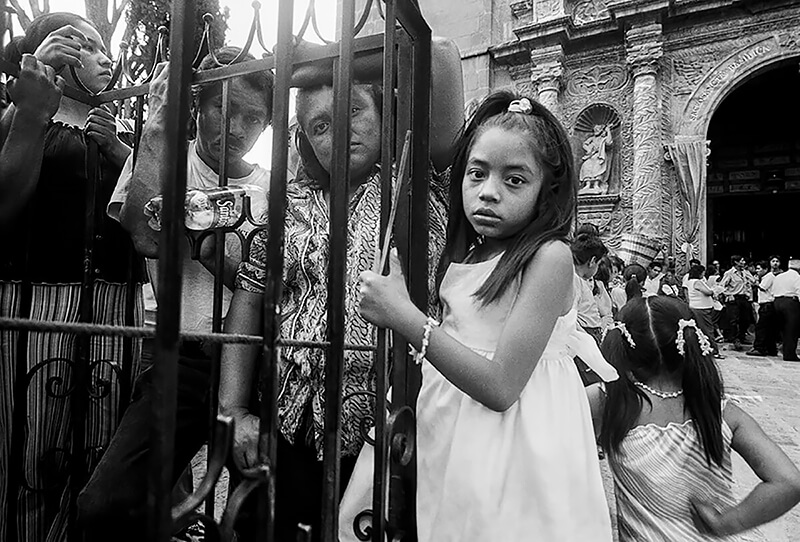
Girl and Others at an Iron Bar, Taxco, Mexico 2003 © Harvey Stein 2018
Largely I am self-taught but when starting out, I took classes with well-known photographers at the time including Ben Fernandez, Laurence Shustak, Ken Heyman, and George Tice. The best advice by far was from Ben, he was a very aggressive street photographer; he said to me, “Get a Leica, a 21mm lens, and go to Coney Island to shoot”. Being the good student that I was, I totally followed his dictate. I bought a used M4 Leica for about $300 and ever since, from about 1972 until today, I shoot black/white film with M4s and a 21 and 35mm lens. I've probably shot at Coney over a thousand times, often bringing my students there. It's become my home away from home, and I've just signed a contract to do my third book on Coney Island.
Who were your biggest influences when you started? Now?
I try not to have influences, I prefer to follow my own muse. But inevitably, Garry Winogrand is a strong influence. I regard him as the best street photographer ever. I like Arbus, Friedlander, Avedon, Cindy Sherman, Andrea Modica, Roy DeCarava, Daido Moriyama, Peter Hujar. a wide range of photographers. There are so many terrific photographers past and present. I favor mostly those from years ago, I try not to keep up with current work, I don't want any undue influences creeping into my work. Besides, that takes up a lot of time. But I do love seeing gallery and museum exhibits of great photography.
When/Why did you decide to become a teacher at ICP?
I began teaching at the
International Center of Photography in 1976, while I was working in advertising on Madison Avenue. I didn't tell them that I had a full-time career in the business world. I believed that they wouldn't take me seriously or even hire me if they knew I had a job outside of the art world. I was good at hiding it, teaching either evening or weekend classes. I knew the photographer Charles Gatewood and he recommended me to the woman who hired teachers. I thought I'd be more involved with the photo world by teaching, but didn't know whether I'd be good at it. Also, it was a way to supplement my income.
Apparently, I am good at it, since I've taught there every year except one between 1976 and now. Still at it, I regard ICP as a very special place where I've met terrific people and have made many many friends.I've taught at ICP longer than anyone except one teacher. They will have to drag me out to get me to quit teaching. Since 1996 I've taught my own workshops in addition to being at ICP, I've taken students to Italy for 12 years, Mexico for about 10 years, India five times, Ecuador, Peru, Argentina, China, Vietnam, Cambodia, Laos, Greece. It's been quite wonderful and mind expanding for me.
Why did you decide to become the Director of Photography at Umbrella Arts Gallery?
I knew the owner of the gallery, MaryAnn Fahey, I'd exhibited at a previous gallery she had, and we became friends. I could see that she didn't know that many photographers from which to arrange exhibits, so I offered to help and be available. My role was to choose artists to exhibit and to curate the shows. It was a small gem of a gallery in Manhattan's East Village on a very beautiful street full of interesting boutiques and small businesses. I was the Director of Photography from 2009 until 2019 when we lost our lease. We did about eight shows per year and produced small, intimate books of many exhibits. We are looking for a new location, but with the crisis, that will take some time.
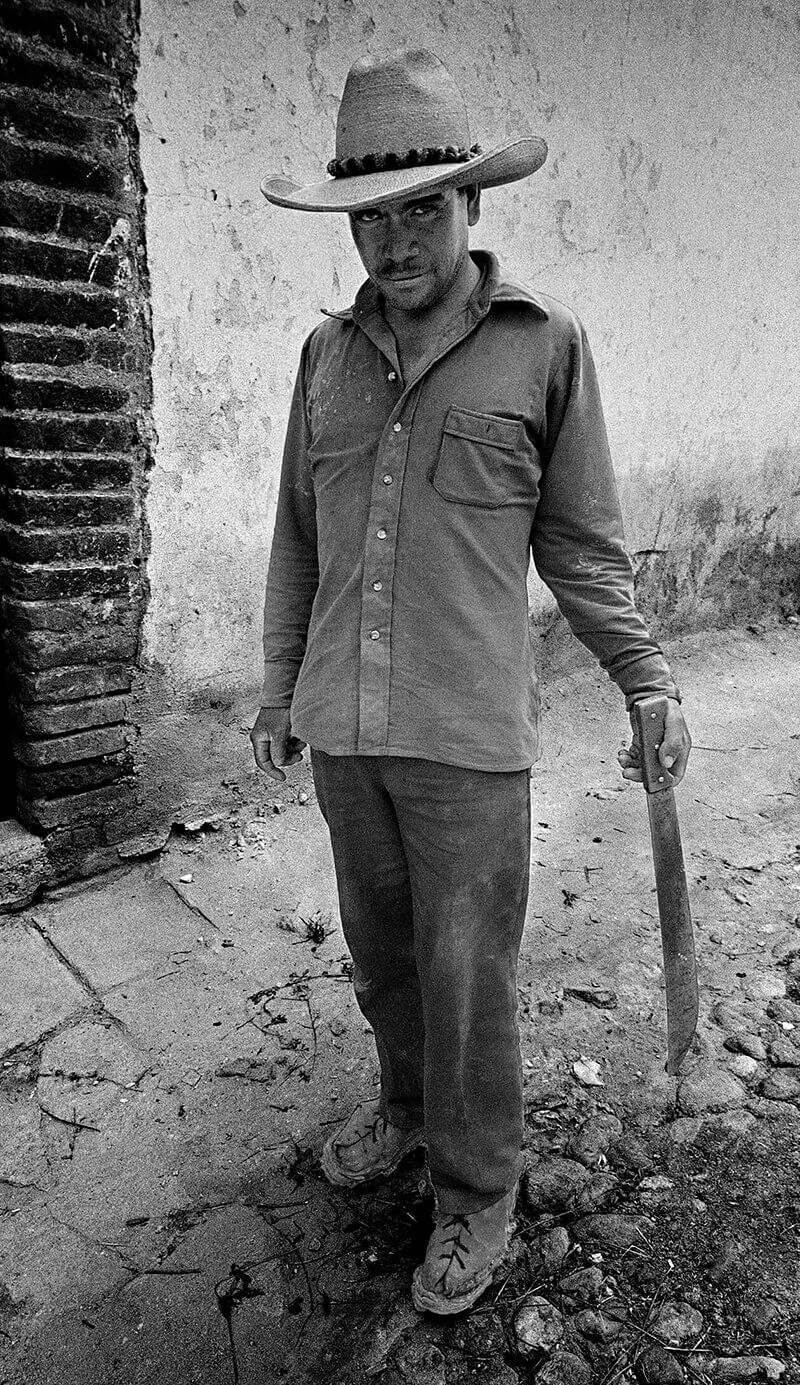
Man Holding Machette, Pozos, Mexico 1995 © Harvey Stein 2018
It's all a balancing act. I love photographing and being a photographer so that is what I spend most time on. I very much enjoy teaching but only teach one day a week usually, so I can keep that in perspective. I don't spend much time at the gallery, it's not necessary. I am in touch with lots of photographers from which to curate exhibits, and I was contacted by many interested people to exhibit. That is all on hold now until the crisis is over. I am relatively organized so I can juggle these separate disciplines, but sometimes finding time to do everything is difficult. Especially when I am in Asia or South America teaching my workshops.
What is the most rewarding part of being a photographer for you?
My photographs reward me. I have to like/love my work, and I often do. If others don't appreciate the work, I can handle that, I have to please myself first. I say my photographs, my image making sustains me. It's out of the work that wonderful things happen, that inspiration and serendipity and mistakes and learning and success happen. Be open, be as free as possible, and trust yourself and the process. My photographs guide and speak to me if I am open to them; things unfold, slowly, like a flower, and it's always interesting and exciting. I don't think about being perfect, that won't happen; it's just an excuse not to go forward. I try to eliminate barriers, plunge in, make mistakes, and incorporate them into the work. That's progress and my perfection.
A teacher?
I also am devoted to teaching, the ideal counterpoint to the aloneness often experienced when working as a photographer; teaching connects me to all kinds of individuals. I feel rewarded when I make a difference in a student's understanding of a concept or when someone says one of my classes changed his/her life. I've been told this often That is major. I feel rewarded when students take my workshops many many times, There are quite a few people who have taken my travel workshops 10 times or more. When I see excitement and interest and very good work from students I feel rewarded. Likewise when I see growth in a person's approach to photography and their work improves over let's say a 10-week class. All this makes teaching worthwhile and gives me the feeling that I am contributing.
A curator?
I am rewarded when an exhibit I curate looks terrific and comes together well. And when I can help the artist edit and sequence his/her show and even point out some things that they might not be aware of in their work, including themes and connections among the images.
What inspires you?
Street life inspires me. I remember when first moving to New York City how I loved riding the subways. They were fast, easy to use, inexpensive, but best of all, they were often crowded with the most diverse people on the planet. All sizes, shapes, ages, and colors of humans imaginable. I first lived in Greenwich Village and traveled on the #1 train up to 116th Street to Columbia University for my classes. I was in awe of the people and variety of faces in the train. I wished I could photograph them, and it turns out that I did eventually.
Among your works, which one is your favorite? Why?
I've done eight photo books, the cover image of each book is probably my favorite image in the book, here are a few.
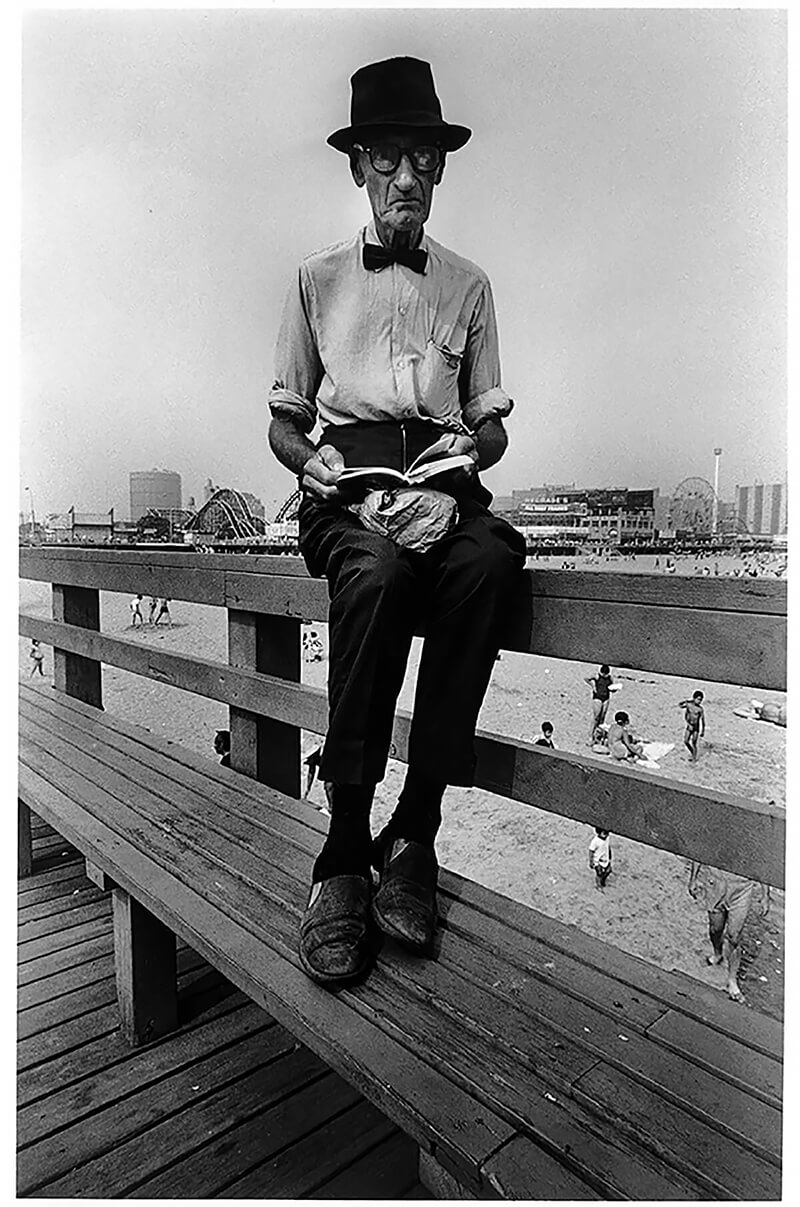
Man Wearing Bow Tie, Conley Island 1970 © Harvey Stein 2011
This photograph was taken in the summer of 1970 at Coney Island. I was interested in photography but working as a marketing executive at a consumer products company. I was enrolled in photography classes in my spare time and went to Coney Island as a result of a class I was taking with Ben Fernandez. I saw this skinny man who seemed from the distant past, sitting on the railing of the fishing pier at Coney. He was looking down at his book and didn't see me initially. I dropped to one knee and took a photo. He must have heard the camera's click; he looked up and saw me. At that instant, I took this photograph. He immediately waved his arm vigorously across his body and yelled, “get away, get away”. I did, thinking that indeed I took an exceptional photograph. It became the first photograph I ever sold and published, in the December 1970 issue of Life Magazine. I've always thought it a great way to start a photography career and hoped that it wouldn't be downhill from there.
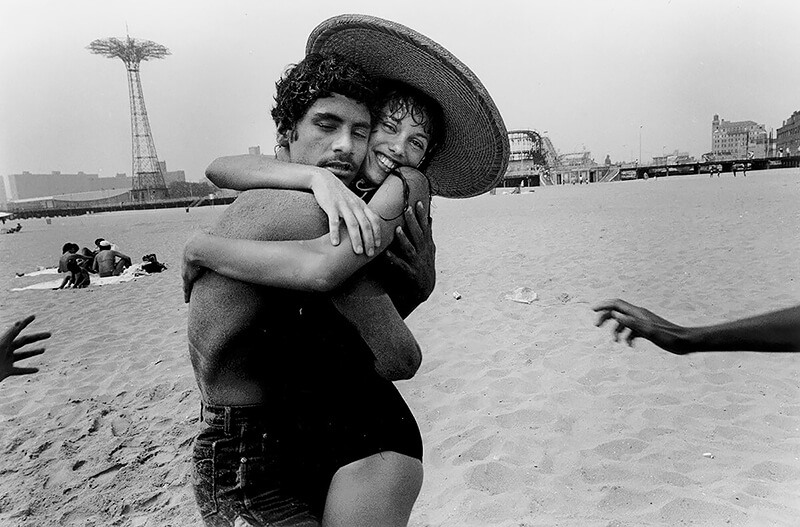
The Hug -Closed Eyes and Smile, Coney Island 1982 © Harvey Stein 2011
I took The Hug in the summer of 1982. I recall that as I was walking on the beach I came across perhaps a group of 10-15 young people (various ages, I'd think they were mostly Hispanic), hanging out on the beach. I went up to a few and they were happy to be photographed, I shot about 15-20 frames, one photo of most of the group is also in the book and on the back cover of
Coney Island 40 Years. I think the two people in The Hug offered to pose for me, and of course I accepted and shot them. The two hands reaching into the photo from each side of the frame were friends of the subjects, I recall that they were just being playful and probably also wanted to be photographed. The hands/arm are an important component of the image and add depth and interest to the photograph. I probably spent about 20 minutes with the group, and then I continued on my way. I've had no contact since.
These two images show my methodology as a photographer. I prefer to photograph my subjects in public (on the street, beach, etc.) in what I call a confrontational/collaborative way rather than candidly. By confrontational, I mean approaching a subject and trying to photograph them closely and with their knowledge (usually with their co-operation), this doesn't mean I ask, usually I tell them I'm going to photograph them either with a nod of the head or with words. By collaboration, I mean that they know and are OK with being photographed. I don't like shooting candidly although sometimes I do, but I feel that it is rather sneaky and I don't feel good about that. Further, I believe I achieve stronger photographs shooting with the subject's cooperation, as I did with The Hug.
I always use wide angles lenses, this allows me to get close and still show the subjects background and environment. Wide angle lenses push space away; I never use telephoto lenses, these bring the subject closer but in a flat and impersonal way. I prefer to get physically close to my subjects, it usually results in a more powerful image and an enjoyable interaction and perhaps discussion., For me, showing the subjects environment adds to the story or situation I am trying to reveal in the photograph. I work quickly, try not to take too much of my subject's time but I also enjoy a conversation and some contact.
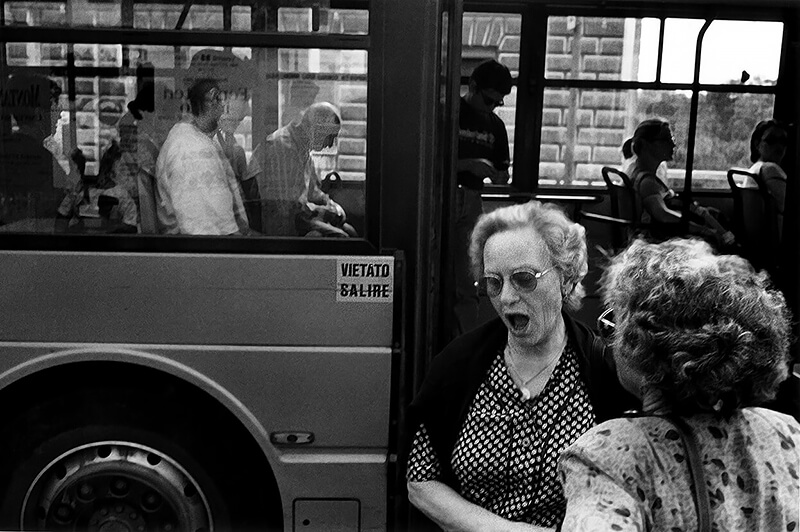
Two Women Talking, Siena, Italy 1999 © Harvey Stein 2006
I taught photo workshops in Italy from 1996 to 2008, it's one of my favorite countries. It offers great food, history, art, scenery and very accommodating people. A favorite city is Siena, it feels very medieval in its architecture and streets. For this image, taken in 1999 with my Leica M4, 35mm lens, I was standing at the entrance of a bus (this is an outdoor bus station) waiting for it to leave and saw the two ladies talking very excitedly. I waited and took probably four photographs, this being the best. Of course, her facial expression says it all. But I also enjoy the passengers waiting on the other bus, each is in his/her own space and world, some weary, some patient, some daydreaming. I always have my cameras with me, especially on buses, trains, airplanes, even subways. You never know when a great photo opportunity will occur.
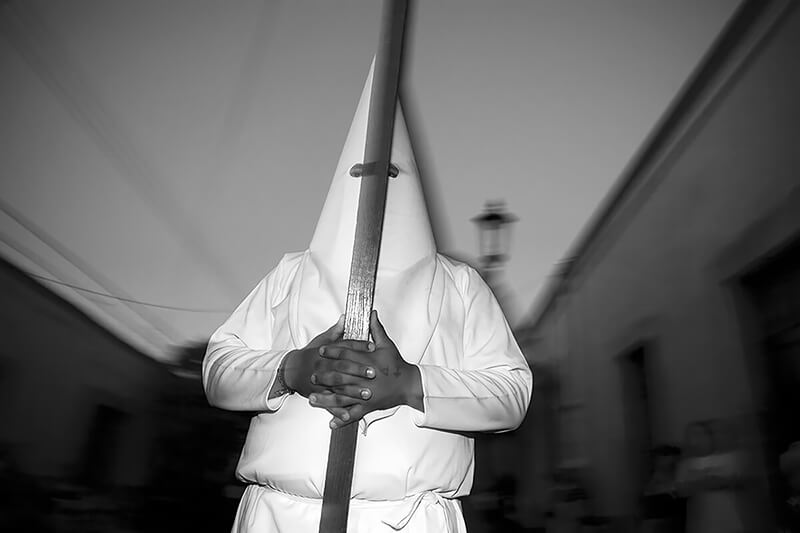
Hooded Man Holding Post, Queretaro, Mexico 2007 © Harvey Stein 2018
I find Mexico fascinating, a very different culture, yet so close to the U.S. It offers sights not even imagined and the warmth of the people is intoxicating. I traveled there almost yearly between 1993 through 2010 and produced the book
Mexico: Between Life and Death, published in 2018 by Kehrer This image was taken in March 2008 during a silent procession in Queretaro as part of the Easter holiday. The procession dates back to the 14th century, it's been said that the KuKlux Klan got the idea for the use of hoods from this event. An amazing week in Mexico is Semana Santa, holy week. It's filled with religious processions, mostly at night, that offer exciting shooting possibilities. I used flash with a slow shutter (1/20 sec) that properly exposed the person and simultaneously underexposed the background, but with enough light to give some details behind the person. He is stopped, but his slight movement caused some ghosting on his left side and my movement caused blur in the background. I'm low, shooting up with a 21mm lens. For me, this all adds to the mysteriousness of the scene.
What makes a good picture stand out from the average?
I look for meaning, composition, strong lighting, emotion, and a clear connection to and involvement with the subject in my photographs. Mostly I want a human presence close to the lens. Photography engages the eye, the mind and the heart. It conveys the photographer's vision, ideas, and emotions. A good photograph makes the viewer think, and stirs feelings. It keeps the viewer in front of it for more than the second or two that it takes to look at, it keeps us there, perhaps disclosing, telling, explaining something to us that we didn't know or quite understand before. It enlarges our world, just as a great book or travel does. Rather than showing us what we usually see or already know, good photographs go beyond to reveal to us what we haven't seen or known in a visual way that enlarges our experience of the subject. 0ur eyes, mind, and hearts are engaged and we are moved, if not changed. More cannot be asked.
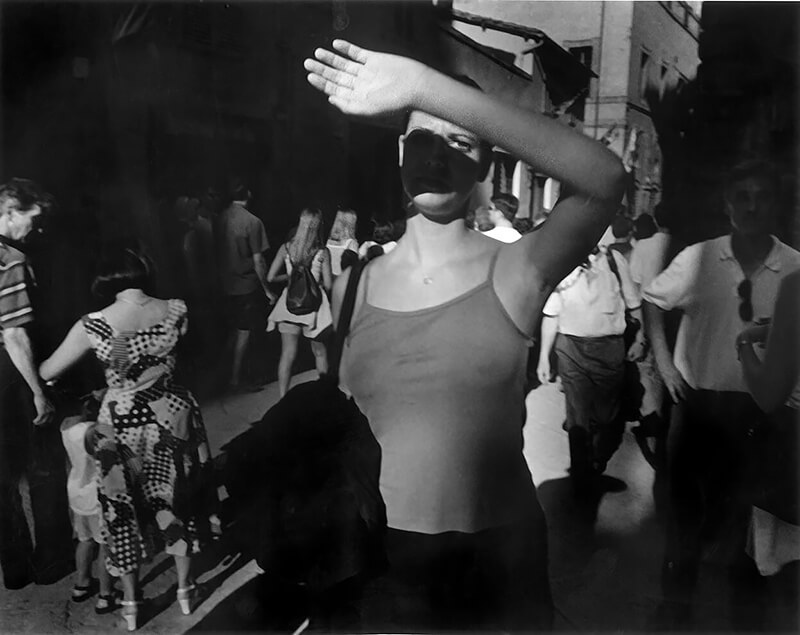
Woman Shielding Eyes, Siena, Italy 1999 © Harvey Stein 2006
I don't aspire to tell a story in a single image, I try to make the strongest photograph that I can, given the situation that I am in. I think the notion of telling a story in a single image is overhyped and overrated. Not so in a series or photo essay. That is a different situation. I do long term projects on a single theme that I try to turn into a book. Hence, I photographed identical twins from birth to death for six years which became the book
Parallels: A Look at Twins (1978). For six years I interviewed and photographed 165 artists in their studios with their art and it became the book
Artists Observed (1986). My latest book,
Mexico Between Life and Death (2018) was shot over an
18-year period. The real challenge for me is to produce a body of work in a consistent way over a long period of time; the task is to stick with it and dig into the subject deeply while making as strong a statement as possible about some aspect of the world.
How do you choose your subjects? Is it a long process?
Usually my subjects choose me. I keep going to the same places to photograph. Sometimes I get enough good images initially to make me want to return. Before I know it, I have 10-20 photos that I like on a specific theme. This spurs me to keep returning. I get to know the area, the flow and moods and geography of the place. Before I know it, and almost as if by magic, I'm involved with the subject and want to do a book about it. Hence, I shot in Italy for about 11 consecutive years and produced the book
Movimento: Glimpses of Italian Street Life (2006). I've done two Coney Island books, one took 27 years, the other,
Coney Island 40 Years (2011) took that long to do. Sometimes I know right away what I want to shoot and how to pursue it. Other times it can take several years of shooting before I know what my subject really is. There is no one way that I know.
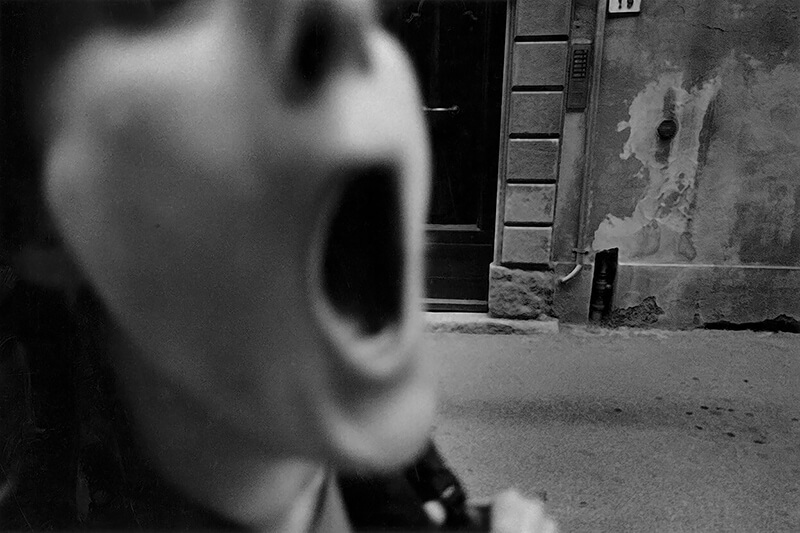
Woman, Siena, Italy 1996 © Harvey Stein 2006
With some exceptions, I want to shoot three or four feet from my subjects. Now, today, with the virus in NYC, there is no way to get that close to strangers on the street. I just posted a selfie wearing a mask for the first time where I was very very close, being frustrated by not able to do strangers that close. Will life be so changed that it will be impossible to be three feet away to photograph a stranger? I certainly hope not, we shall see.
I am friendly and smile when approaching people on the street; I have little problem going up to people to make an image. I usually find something to compliment them about, such as, “I really like your T-shirt or your hat, I'll like to take a photo” This is disarming and usually effective. In Manhattan, 50% of the people will say yes, in Brooklyn, 75% of the people will say yes, in India, 99% of the people will say yes. Location is certainly a variable.
How has your work evolved over the years?
In over fifty years of shooting, I've consistently shot with Leica M4 and M6 film cameras. Eighty percent of my work is with a 21mm lens, the other 20% is with a 35mm lens. My long lens is a 35mm. My approach is close, direct, wide angle. So, I conclude that my work has not evolved much over the years. I am happy doing what I do in a focused, constant and coherent way. I do shoot digitally, with a Canon 5D Mark 2, have had this for about eight years. I enjoy shooting with it, especially when I travel, but my mainbodies of work are with black/white film. That being said, I've shot and have produced major bodies of work with a 4x5 camera, the Polaroid SX-70, Holga and Diana cameras, and have made camera less and non-silver imagery in the darkroom. I love shooting with the IPhone and may someday do a book of images taken by phone. But again, I put a premium on being steady and consistent, I've seen too many artists and photographers who produce work all over the place, jumping from style to style and adding up to not much.
What 3 words describe your photography style?
Closeup. Direct. Wide angle.
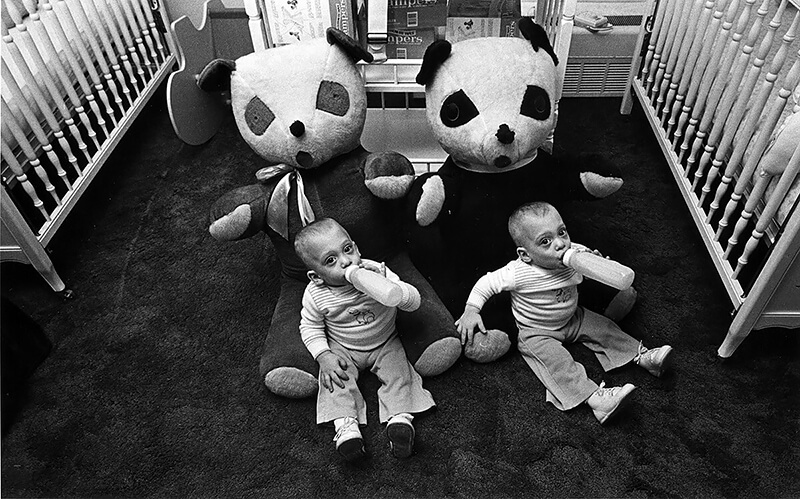
Infant Twins, New York City 1977 © Harvey Stein 1978
I am a black and white photographer, with occasional forays into color. I shot a lot of color slide film until I got my first digital camera in 2006. I still have thousands of slides to look at, which I doubt I'll ever do. My first Coney Island book is in color and my upcoming book,
Then and There: Mardi Gras 1979 consists of Polaroid SX-70 instant color images. I say that for me, color is often pictorial and picturesque whereas black and white is personal. I can be more evocative in black and white imagery. Many shoot colors for color sake, color often overwhelms content. I first and foremost want content and dislike color that overpowers subject matter.
Do you spend a lot of time editing your work?
I spend a ton of time looking and choosing work to use, whether digital color or black and white film. I make contact sheets and closely look at them with a loupe. I print in my darkroom probably once a week; it takes me hours of looking at contact sheets to select what I print. I am in the darkroom for the day, at least 10 hours, and leave with 8-10 negatives printed, perhaps four images per negative for a total of 34-40 prints. It's a long and tiring day, but worthwhile since I realize the physical manifestations of my shooting.
What can you tell us about your upcoming book Then and There: Mardi Gras 1979?
This book is quite different from any I've had published. Zatara Press is doing the book, it is an independent, small press, photography book publishing company created in 2014 by Andrew Fedynak to give a voice to a variety of projects through the medium of unique artist's styled photobooks. Andrew approached me with the question, Do you have any work that you like that would be surprising coming from you since you are known for black/white street photography. After thinking about this question, I suggested my Mardi Gras photographs that I took in 1979 with a Polaroid SX-70 instant camera. This camera was in vogue in the 70's and 80's. It spit out a single approximately 3 ½ x 4 ¼ inch photo that develops before your eyes within a minute. A few weeks later I showed the SX-70 prints to Andrew and immediately he said he wanted to publish a book of them. The book consists of 47 photographs shot closeup with flash at twilight of people in masks and/or face paint. The raw excitement of Mardi Gras flows through each portrait with the people physically filling the entire frame of the Polaroid as if the print itself were a stage just for them. SX-70 images often fad over time, but for some reason, the colors in my shots have remained strong and vibrant over the years. The book is a small gem, printed in Spain with photos hand tipped onto the front and back covers. I am very excited about this book. The introduction of it was to occur in early April at the Paris Photo New York International Art Fair in New York. But of course, that was cancelled due to the coronavirus. We are delaying the introduction to the early Fall, books are not of interest during the crisis.
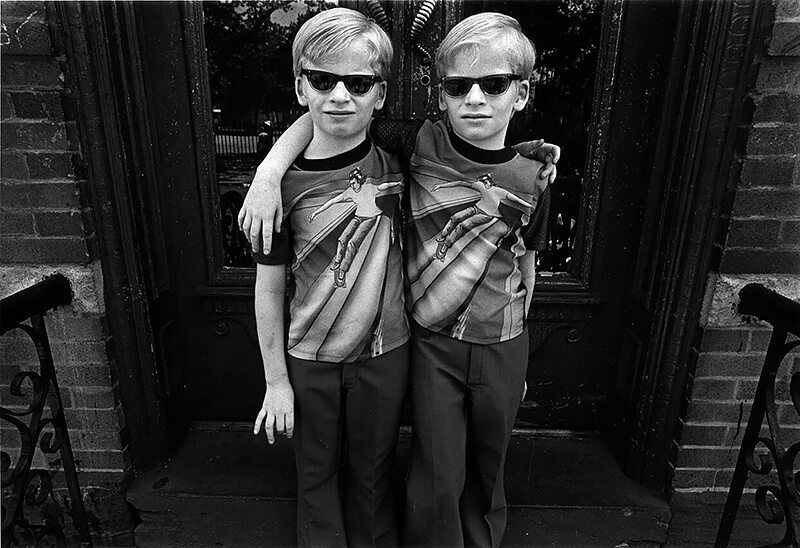
Nine Year Old Albino Twins, New York City 1977 © Harvey Stein 1978
I'd say my biggest accomplishment is producing nine photography books with another coming out in 2022. I have always loved books and enjoyed being in school and learning. Books were a key aspect to my education and still are. I love being on a college campus, and have taught photography at seven universities since the 1970's. Photo books encompass the entire world, one that is at your fingertips. They can be beautiful, maddening, exciting, educational and inspiring. From the beginning of my photo career, I wanted to make books. Within the first year of shooting, I found a great theme to pursue, Identical twins. Six years later I published my first book,
Parallels: A Look at Twins (1978), showing identical twins usually shoulder to shoulder facing the camera, sequenced by age from two months to 71 years old.
I just signed a contract to publish my tenth book, it's called
Coney Island People: 50 Years. These days, it is more and more difficult to get books published, but I still find a way. I am proud of this accomplishment, especially when I consider the books well done and meeting my objectives of being relevant and comprehensive and full of strong work. I don't have children but often feel that my books are what I'll leave behind as a small legacy of my life. I feel that because I've lived, I've filled up the blank pages of my books; that my life is there on those pages, the life that I saw and lived and enjoyed.
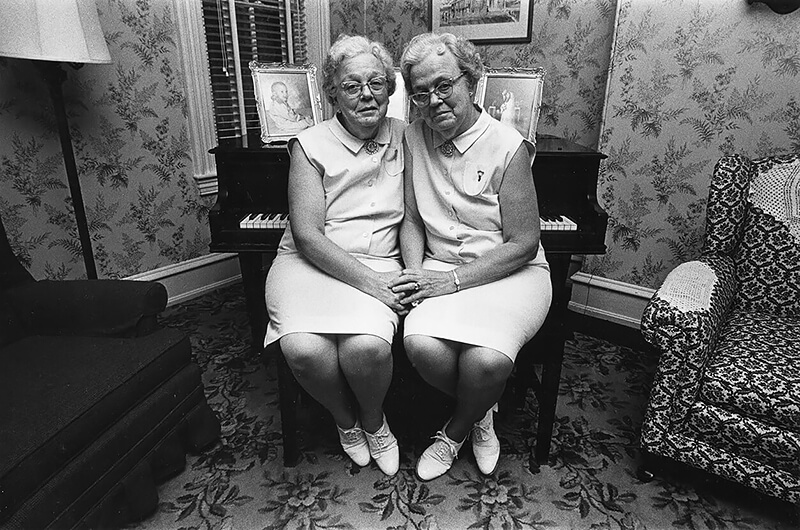
Elderly Twins, Chester, PA 1976 © Harvey Stein 1978
My upcoming project include the introduction of
Then and There: Mardi Gras 1979 which has been delayed due to the coronavirus crises. We are thinking that it will be introduced in early September if things are better then. It's printed and at Zatara Press, the publisher in Virginia. We will work on firming up the marketing plan for it. Just last week I signed a contract for another book,
Coney Island People: 50 Years; I will be concentrating on the book for the next several months. This is the 50th year of shooting for it, so I want to create more images during this year. I've been to Coney this year several times already, but I want to add some shoots. You would think that I've shot enough over all these years, but I always want more, I always think I can do better. Once people are again out and about, I'll be there often. Then there is much work to locate, scan, edit and sequence the negatives/prints for the book, this can take months. Photography isn't just shooting, there is so much more to it, including editing, marketing, thinking about your work, etc., etc. I do have other book projects in mind that I will either begin to shoot or look for images in my archive. I am always busy planning my travel workshops, I am now working on one to Myanmar in the fall and to India next January/February.
I am never at a loss to fill up time, there is never enough time. I love what I do, could never imagine what I'd do without photography, I feel blessed and happy to have found this wonderful way of working, creating and enjoying life.
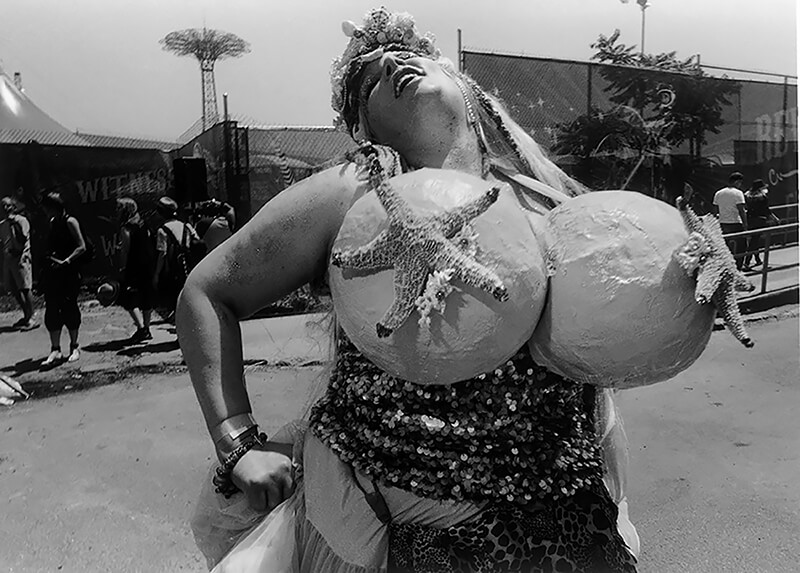
The Happy Mermaid, Coney Island 2010 © Harvey Stein 2011
I photographed this woman at the Coney Island Mermaid Parade in June, 2010. I didn't know her but was drawn to her because of her funny and provocative mermaid costume. I nodded to her to make a photograph and she nodded back in affirmation; she threw her head back and at that instant I took this photo. I used fill flash under her left breast to soften the shadows. My book,
Coney Island 40 Years, was published May 2011 and I was having an exhibit of some of the work at the Alan Klotz Gallery with an opening just after July 4th. The announcement card for the show included this photo. I returned to shoot the 2011 edition of the Mermaid Parade the third Saturday of June and again saw this woman in the same costume. I spoke to her, we introduced ourselves and I gave her the invitation with her photo and invited her to the opening; she loved the card and said she would try to make the opening. Well, she did show up, in this costume, with her mother. Needless to say, everyone wanted to photograph her in the gallery and no one looked at my photographs on the walls after that. It was a very crazy and fun time; she helped to make the evening a big success.
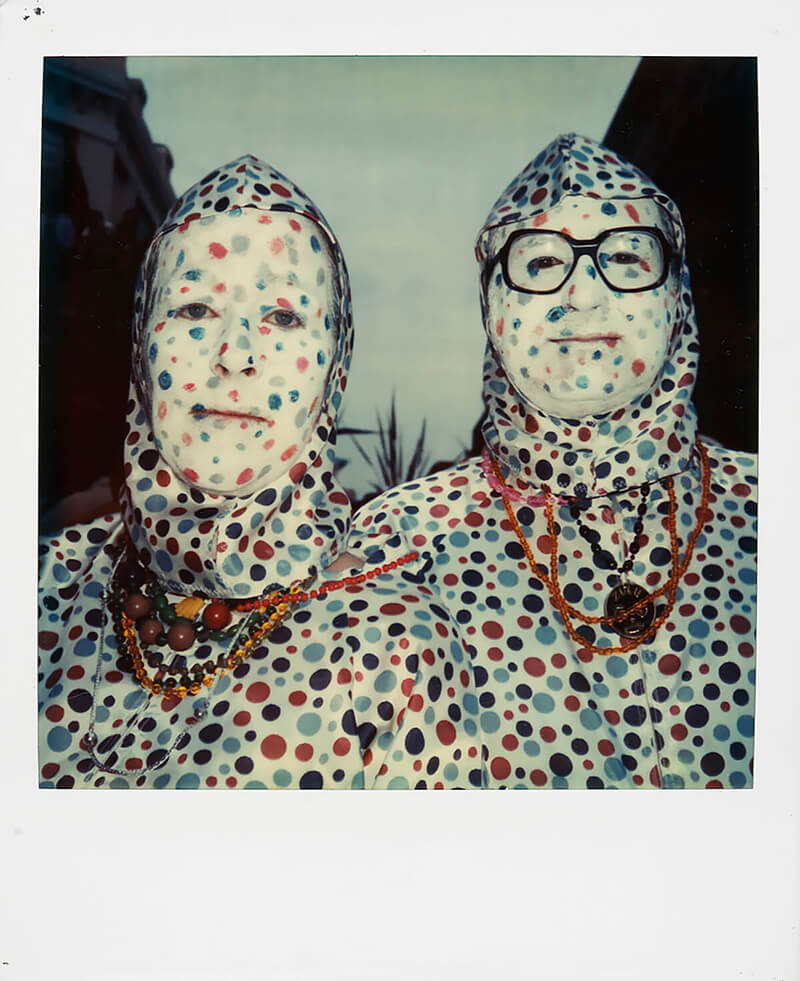
Polka Dot Couple, New Orleans, LA, 1979 © Harvey Stein 2020
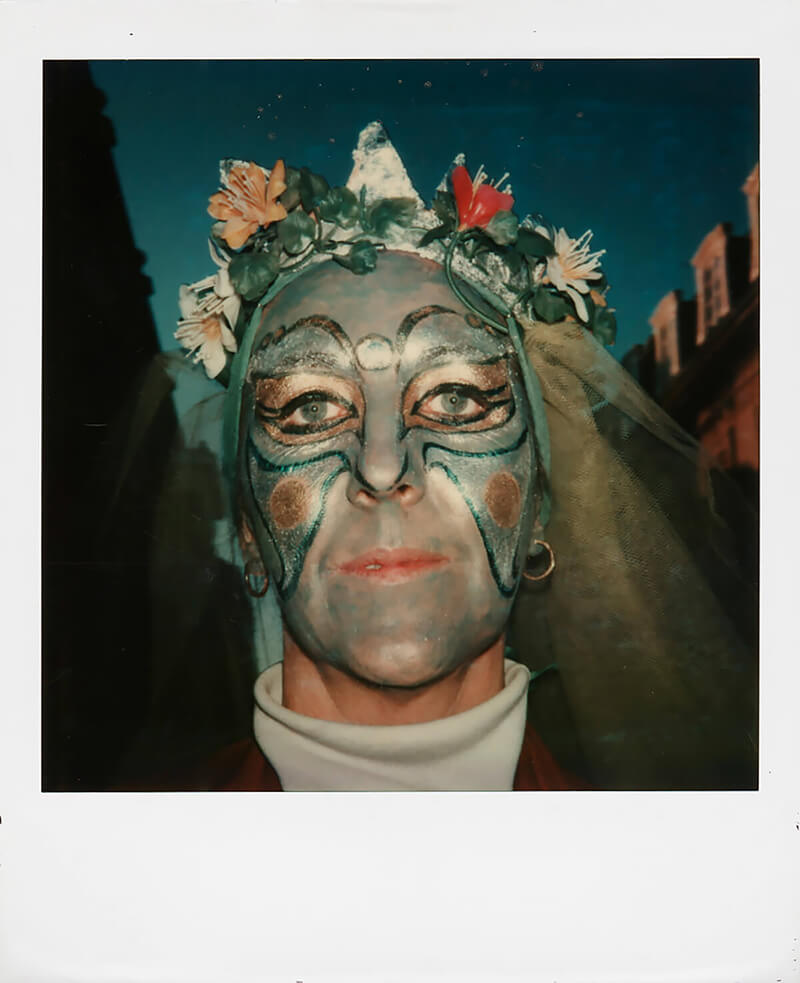
Silver Faced Woman, New Orleans, LA, 1979 © Harvey Stein 2020
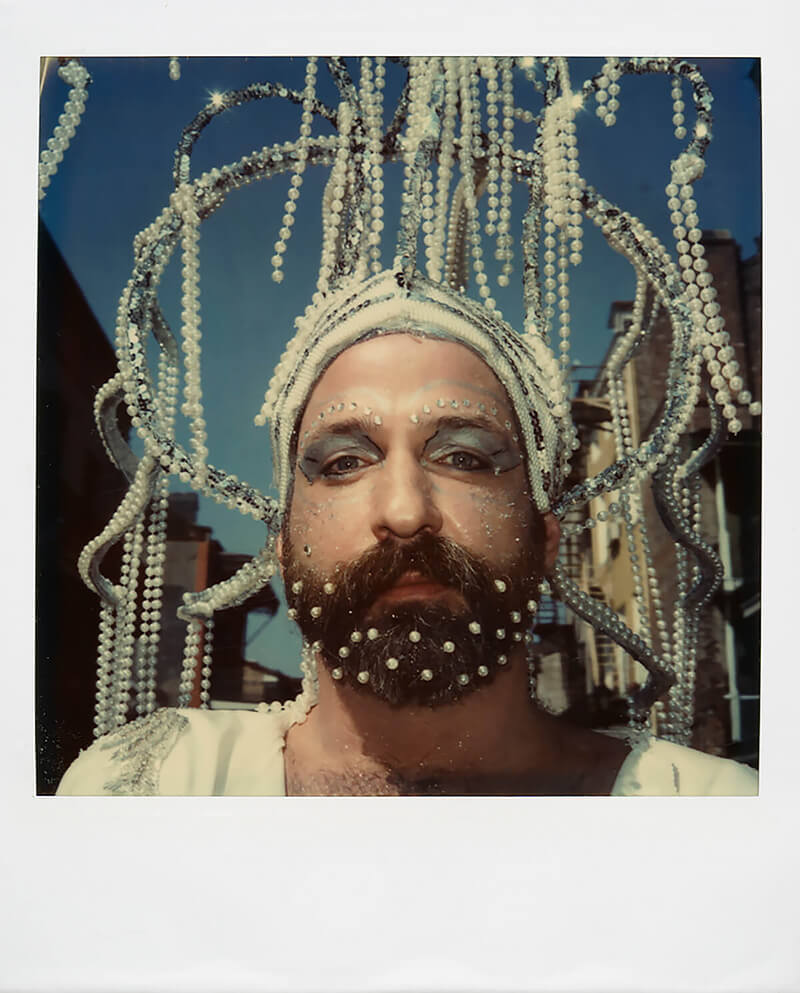
Man with Pearl Headdress, New Orleans, LA, 1979 © Harvey Stein 2020
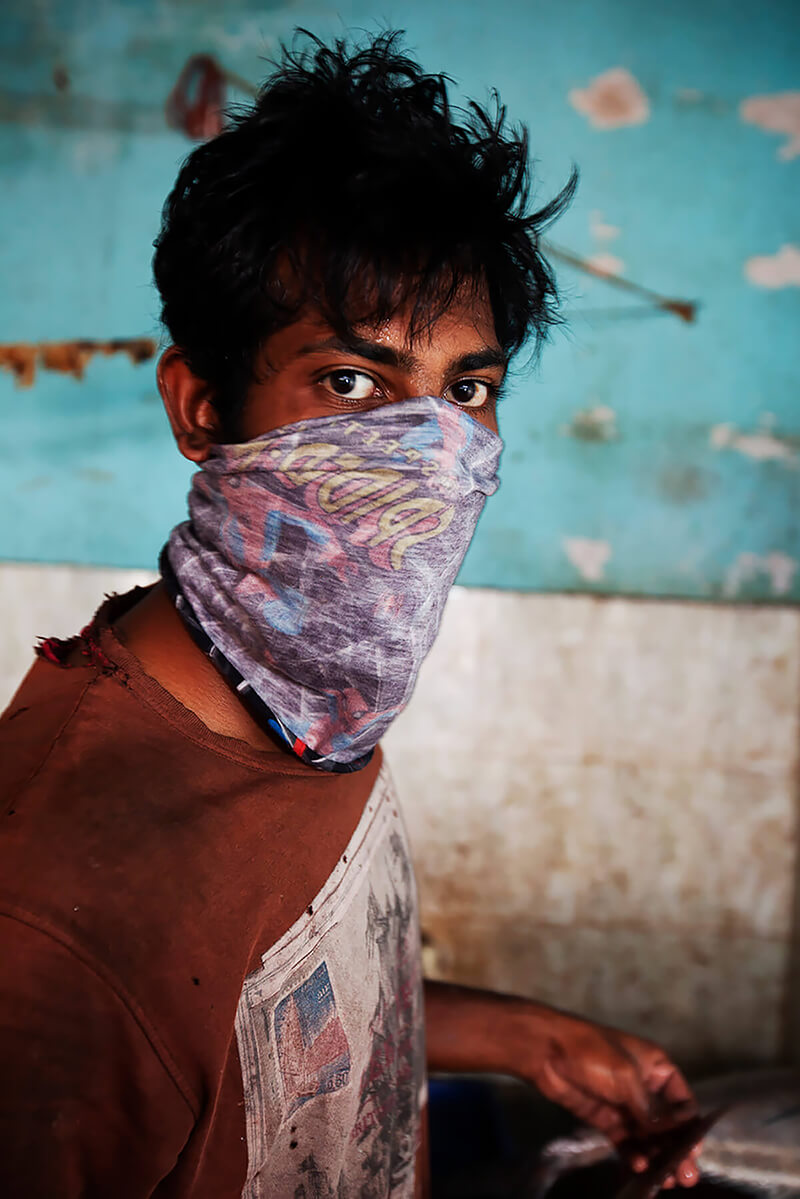
Youth Wearing Bandana, Thrissur, India, 2017 © Harvey Stein 2017
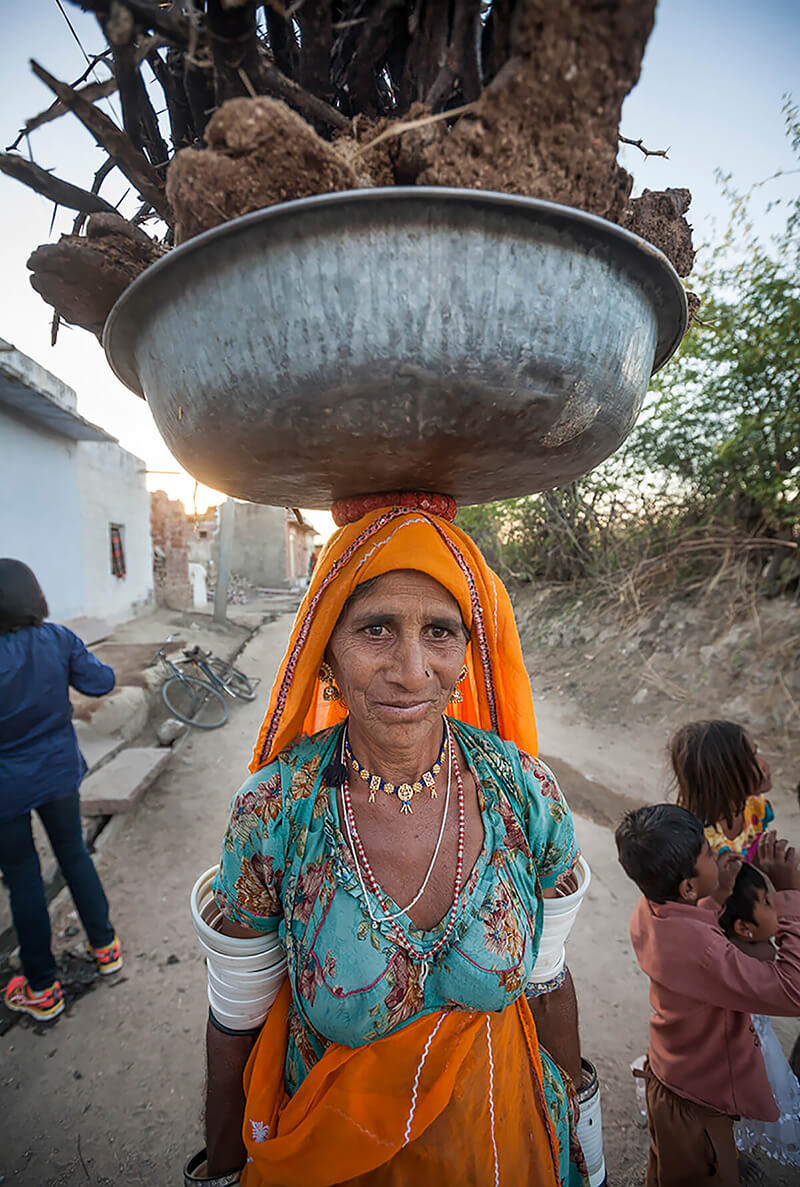
Woman Carrying Wood, Chandelao, India, 2013 © Harvey Stein 2013
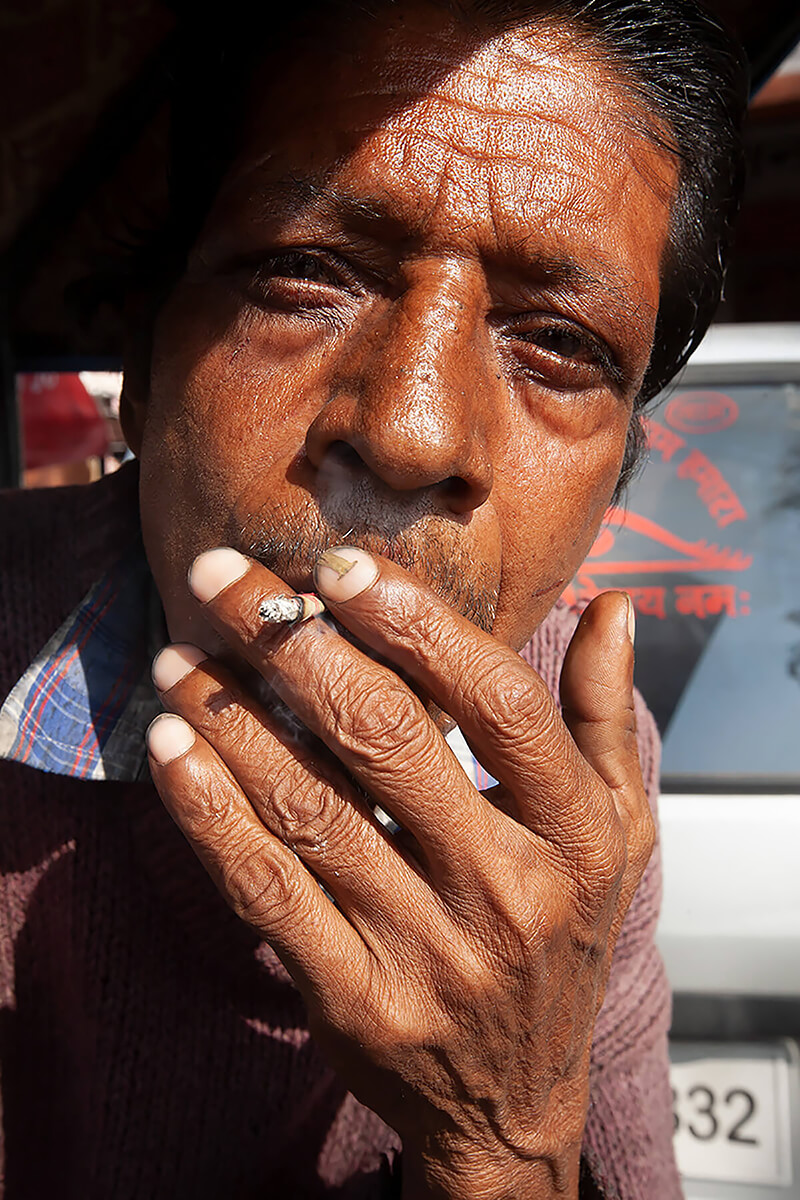
Man Smoking, Jaipur, India, 2014 © Harvey Stein 2014
